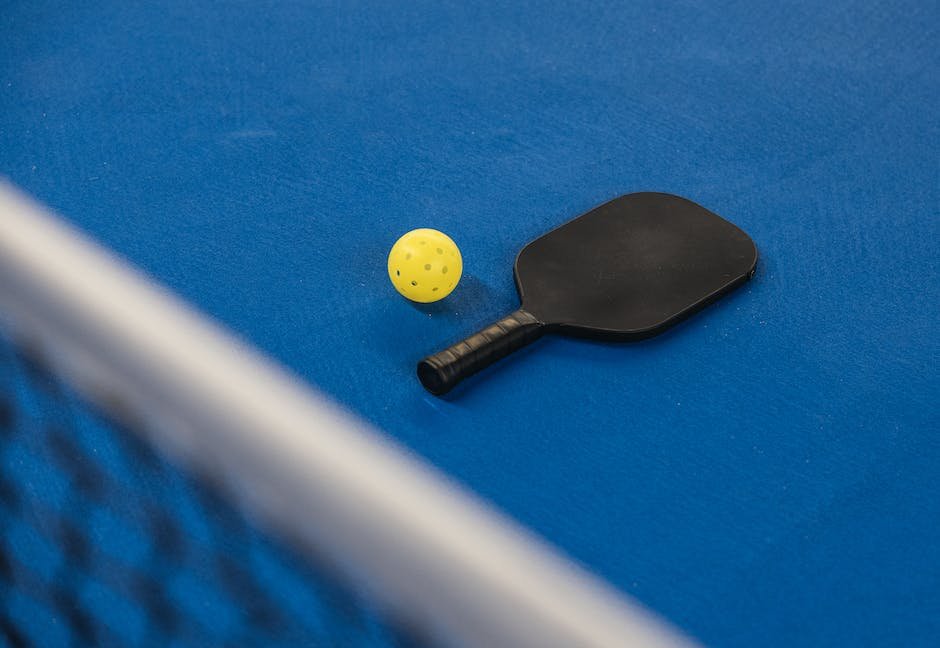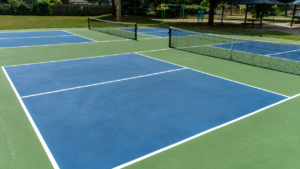Get ready to step onto the vibrant pickleball court, where fickle fortunes are decided by agile maneuvers and strategic strokes. A sport that embraces the essence of tennis, badminton, and ping pong, pickleball enthralls players and spectators alike with its unique scoring system. But fret not, all’s fair in love and pickleball! Whether you’re a newcomer or a seasoned player looking for a refresher, this article unravels the enigma of pickleball scoring, specifically answering that ever-elusive question: Who’s serving now?
Table of Contents
- Understanding the Basics of Pickleball Scoring
- Determining the Serving Order in Pickleball
- Unraveling the Mystery of the First Serve in Pickleball
- Mastering the Rotation: Who Serves When?
- Strategies for Maintaining Control of the Serve in Pickleball
- Q&A
- To Conclude

Understanding the Basics of Pickleball Scoring
Pickleball Scoring:
Scoring in pickleball may seem confusing at first, but once you understand the basics, it becomes an enjoyable part of the game. Unlike traditional scoring systems in sports, pickleball uses a unique method called “rally scoring.” This means points can be scored by both the serving and receiving teams.
Here are the key points to understand about pickleball scoring:
- Serving Side: The serving team must score in order to win the serve. If they don’t, the serve goes to the other team.
- Points: Each time the serving team wins a rally, they receive a point, regardless of who served the ball. This means that even if you’re not serving, you can still win points for your team.
- Winning the Game: In most games, teams play to 11 points, but in competitive play, it can be up to 15 or 21. The winning team must also have a two-point advantage over the opponent.
- Switching Sides: After the first game, players switch sides of the court. This helps ensure fairness, as wind and sun can affect the game.
Remember, pickleball scoring is all about teamwork and strategizing to win points, regardless of whether you’re serving or receiving. Once you grasp the basics, you’ll be able to dive into the exciting world of pickleball with confidence!

Determining the Serving Order in Pickleball
When it comes to deciding who serves first in a game of pickleball, there are a few different methods that can be used. Let’s dive into some of these methods to determine the serving order:
- Flip a Coin: One straightforward way to determine the serving order is by flipping a coin. The players can each call heads or tails, and the winner gets to serve first.
- Rock, Paper, Scissors: Another fun way to determine the serving order is by playing a quick round of rock, paper, scissors. Each player simultaneously chooses one of the three hand gestures, and the winner becomes the first server.
- Spin the Paddle: For a slightly more whimsical approach, players can gather in a circle and take turns spinning a paddle in the center. The person pointed to by the paddle’s end when it comes to a stop gets the privilege of serving first.
These methods are just a few examples of how the serving order can be determined in pickleball. Ultimately, the choice is up to the players, and it can add an element of excitement and anticipation to the game. So next time you gather for a pickleball match, try out one of these unique methods to determine who gets to serve first!

Unraveling the Mystery of the First Serve in Pickleball
The Importance of the First Serve
In the fast-paced game of pickleball, the first serve can often determine the outcome of a match. It is not merely a routine shot, but a strategic move that sets the tone for the entire game. The first serve is your opportunity to gain an advantage over your opponents, forcing them to react and adapt to your style of play. It is a crucial moment where precision and power must come together seamlessly.
The Technique
Perfecting the first serve requires a combination of skill, focus, and practice. Begin by finding your ideal grip, which will allow you to generate maximum power and control. As you approach the service line, visualize your target and mentally prepare to unleash your shot. Remember to keep your body relaxed and maintain a fluid motion as you strike the ball. Aim for the corner of the opponent’s service box, making it challenging for them to return the serve effectively.
Strategies to Keep in Mind
- Variety: Keep your opponents on their toes by mixing up your serves with a combination of speed, spin, and placement. Use slice to keep the ball low and skidding, or add topspin to create an unexpected bounce.
- Placement: Target the weaknesses of your opponents. Serve wide to push them away from the center, or aim for the opponent’s weaker backhand corner to put pressure on their less dominant side.
- Mental Game: Take control of the psychological battle by maintaining a confident demeanor throughout your serves. Stay focused, adapt to the game situation, and use your first serve as a tool to assert dominance.
Mastering the first serve in pickleball is an ongoing process that requires continuous practice and experimentation. Embrace the challenge and explore different techniques to find what works best for your game. As you unravel the mystery of the first serve, remember that it is not only about power and accuracy, but also about outsmarting your opponents and setting yourself up for success. With time and dedication, this crucial shot will become one of your greatest assets on the pickleball court.

Mastering the Rotation: Who Serves When?
When it comes to the game of tennis, the serve is often considered the most important shot. It sets the tone for the entire point and can be a powerful weapon if executed correctly. However, knowing when to serve can be just as crucial as having a powerful serve. In this article, we will delve into the intricacies of the serving rotation in a tennis match.
1. Initial Serve: At the start of the match, a coin toss determines which player gets to serve first. This initial serve sets the momentum and showcases the player’s skills right from the beginning.
2. Serving Alternation: After the first game, the serving rotation begins. Each player takes turns serving, with the receiver changing for every game. The rotation continues until the completion of the set, ensuring a fair distribution of serving opportunities.
3. Tiebreakers: In tiebreaker situations, the serving rotation changes slightly. The player who served first in the previous game serves the first point of the tiebreaker, and then the rotation alternates as usual.
Mastering the rotation is not only about following the rules but also understanding the psychological advantage that the serve can provide. By keeping opponents on their toes and maintaining a strategic approach, players can maximize their serving potential and seize control of the match. So, next time you step onto the tennis court, remember that serving is not just about hitting the ball – it’s a tactical game within the game.
Strategies for Maintaining Control of the Serve in Pickleball
Mastering the art of serving in pickleball is crucial for maintaining control and gaining an edge over your opponents. Here are some effective strategies that can help you dominate the serve:
- Placement is key: Focus on precision rather than power when serving. Aim to place the ball in the opponent’s weakest spot on the court, forcing them into a defensive position right from the start.
- Spin it to win it: Incorporate spins and slices into your serves to add another layer of complexity. A well-executed spin can catch your opponents off guard, making it harder for them to return the ball effectively.
- Change up your speeds: Don’t become predictable with your serves. Vary the pace and tempo to keep your opponents guessing. Alternate between fast and slow serves to disrupt their rhythm and exploit any vulnerabilities.
- Mix up your placement: Avoid serving to the same spot repeatedly. By constantly changing your target areas, you force your opponents to constantly adjust their positioning, making it harder for them to anticipate your next move.
- Take risks strategically: While consistency is essential in pickleball, don’t shy away from taking calculated risks with your serve. Surprise your opponents with an occasional aggressive or unconventional serve to keep them on their toes.
By implementing these strategies and adapting them to your own playing style, you’ll be able to maintain control of the serve, putting yourself in a favorable position to dominate the game.
Q&A
Q: What is the basic scoring system in pickleball?
A: The scoring system in pickleball is similar to tennis. Points are only scored by the serving team, and games are played to 11 points, with a win by a margin of two.
Q: How do you decide who serves first?
A: To decide who serves first, a coin toss or paddle spin is usually performed. The winner can choose to serve first or select the side of the court they want to play on.
Q: How does the serving rotation work in pickleball?
A: In pickleball, the serving rotation is determined at the beginning of the game. The first server always starts serving from the right side of the court. Once the first server loses their serve, the serve rotates to their partner who starts serving from the left side.
Q: What happens when the serving team wins a point?
A: When the serving team wins a point in pickleball, the server gets to take another serve from the opposite side (right or left) of the court. This continues until they lose a point, at which point the serve rotates to the other team.
Q: What are the basic rules for keeping score in pickleball?
A: In pickleball, the serving team’s score is always announced first, followed by the receiving team’s score. The score is called out in a sequence: server’s score, receiving team’s score, and then server’s number. For example, the score might be called as “4-2-1.”
Q: How does a game in pickleball end?
A: A game in pickleball ends when one team reaches 11 points and has a lead of at least two points. However, if both teams tie at 10 points, the game continues until one team gains a two-point lead and wins.
To Conclude
And there you have it, a beginner’s guide to the pickleball scoring system that will make you a pro in no time. Whether you’re a complete newbie or a seasoned player wanting to refresh your knowledge, understanding the intricate rules of who’s serving now is crucial to your success on the court. Just remember, keep your eyes on that pickleball and stay focused on the score, and you’ll be acing your serves and scoring points like a true pickleball maestro. With practice and a bit of strategic thinking, you’ll be dominating the game, feeling the thrill of victory, and enjoying the camaraderie of this fantastic sport. So grab your paddle, find some fellow enthusiasts, and get out there to show off your newly acquired pickleball scoring expertise. It’s time to serve up some pickleball magic!
As an affiliate, my content may feature links to products I personally use and recommend. By taking action, like subscribing or making a purchase, you’ll be supporting my work and fueling my taco cravings at the same time. Win-win, right?
Want to read more? Check out our Affiliate Disclosure page.




